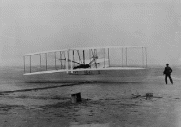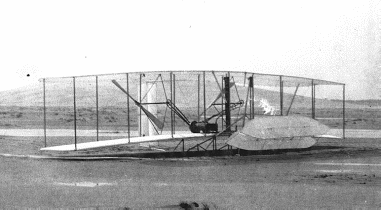The credit for the invention of the first powered airplane goes to the Wright brothers Orville and Wilbur. The worlds first powered, sustained and controlled flight in a heavier-than-air airplane was achieved by the Wright brothers using the airplane named Flyer in 1903. The Flyer was a canard biplane as it had its tail in the front. It could only carry the pilot. It was powered by a 9-kW (12-hp) Wright Engine that drove two push propellers turning in opposite directions. The drive chain was crossed for this purpose. Take off was made possible through a two-wheel trolley that carried the Flyer on a 18.3m (60ft) wooden rail. The wings were curved and covered with muslin. The upper and lower wings were joined by nine pairs of strong struts and kept firm with the aid of wires. The airplane consisted entirely of wood, which was mostly spruce. On December 17, 1903, the Flyer did four flights, the longest of which was the last. In this flight the Flyer covered a distance of 260m (852ft) in 59 seconds.
Information regarding the inventor, the society, and circumstances surrounding the invention
Wilbur Wright was born in 1867 and Orville Weight in 1871 to Milton Wright and Susan Catherine Koerner. Their education consisted of high school education, but they did not receive diplomas. The craze for bicycles in the U.S.A. drew them to opening a bicycle repair and sales shop. Their interest in flight developed with the advent of gliders and the national interest in them. Using their experience in bicycles, they progressed to developing gliders and finally providing control and power to progress to the first powered flight. Their success with the Flyer was initially met with skepticism in the U.S.A, as people did not believe that powered flight was possible, and that too by these bicycle mechanics. However their later developments gave legitimacy to their claims and led to airplanes becoming accepted by society and the armed forces.
How this invention changed the society of origin
How (and when) this invention was introduced to other societies and the impact it had upon introduction
European society was just as skeptical of the claim of the Wright Brothers to the first flight. In 1908 Wilbur Wright arrived in France with the Wright model airplane, and over a period of one year made more than 200 demonstration flights in Europe. The critics in Europe turned to admirers and the Wright brothers became heroes. The French and Germans contracted to build the Wright aircraft under license, and flight became a reality in Europe.
Why this invention is considered one that changed the world
The invention of the airplane by the Wright brothers has redefined the concept of time and distance. Since the advent of the airplane people no longer think in terms of days and months for transportation needs, instead people think in terms of hours and days. The airplane has made it possible for large groups of people to move from one place to another, which has vastly increased the migration of people from region of the world to the other. Transportation of goods also takes place by using airplanes. Goods transported in such a manner take very short periods of time to reach their destinations. In essence it can be said that the airplane has verily shrunk the world.


Works Cited
“First Airplane Flight”. 1996. Wright Brothers History. 2007.
Chant, Christopher and Taylor, J. H. Taylor. The World’s Greatest AIRCRAFT. Isle of Anglesey: S. WEBB & SON, 2001.
“Wright brothers”. Wikipedia, the free encyclopedia. 2007. Web.
“Demonstrations in Europe”. THE AERIAL AGE BEGINS. 2007.
Gunston, Bill. Howatson, Ian. and Quigley Sebastian. THE WORLD OF FLIGHT. London: Horus Editions Limited, 1995.
“Inventing the Airplane”. Web.